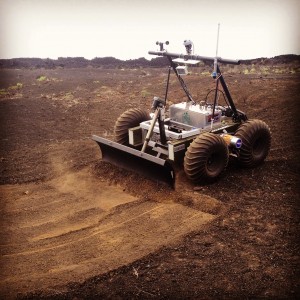Hilo-based Aerospace Agency to Share $119K NASA Grant

PISCES’ planetary rover “Helelani” successfully completed an ISRU construction project in 2016 with Honeybee Robotics. Photo courtesy of PISCES.
A Hawai‘i state aerospace agency based in Hilo is a joint recipient of the $118,690 NASA Small Business Technology Transfer (STTR) grant to research and develop space construction technology.
The Pacific International Space Center for Exploration Systems (PISCES) and New York-based Honeybee Robotics, Ltd. will use the STTR funding to develop an In-Situ Resource Utilization (ISRU) technology that could enable the future of space settlement.
ISRU is a process of turning locally sourced, raw materials into usable resources. On remote places like the Moon and Mars, ISRU can transform the thin, rocky layer of surface soil into important resources like oxygen, water, rocket fuel and construction materials.
PISCES and Honeybee Robotics have partnered on the 12-month ISRU project to develop building blocks made entirely of sintered Hawaiian basalt. Hawai‘i’s basalt closely resembles Martian and lunar basalt, and the technology could be used both in Hawai‘i and in space for construction. ISRU building blocks could be used for habitats, tools, shelters, roads, landing pads and other critical infrastructure required for space settlement. Sintered basalt could also provide a sustainable new construction material for the State of Hawai‘i in place of imported cement.
PISCES is currently investigating the ideal sintering temperature to create these building blocks with an optimal balance of strength and volume. Honeybee Robotics is designing a robotic process for creating and deploying the blocks to automate the construction process. The Brooklyn-based company designs, builds and integrates technologies to withstand a range of challenging environments including space exploration. It has contributed sample collection and processing instruments for NASA rovers currently exploring Mars.
“We are excited to be working with Honeybee Robotics again on this NASA STTR project,” said PISCES Program Manager, Rodrigo Romo. “Honeybee was a key partner in our robotically built launch and landing pad that we constructed using only local basalt materials. This grant award will take the process a step further, allowing us to optimize the building block design and construction materials to allow for both vertical and horizontal construction applications that can be used both on Earth and on other celestial bodies for space settlement.”
“Hawaiian basalt is a great analog to the challenging environments we are likely to find on Mars or the Moon, where autonomous ISRU systems will need to work reliably and autonomously in tough conditions,” said Kris Zacny, vice president of the Exploration Technology Group at Honeybee Robotics. “Using local resources will be critical to enable new mission architectures by harvesting materials from the planet as needed. Also, approaches we develop for ISRU can also have applications in space mining, opening doors for both exploration and commercial missions. That’s why we’re so excited to be working with PISCES to advance our experience and robotic technologies.”
The STTR-funded project is the first phase of development for basalt-based planetary building blocks. Once complete, PISCES and Honeybee Robotics intend to apply for a Phase II STTR grant for funding of up to $1 million over two years.
The joint PISCES-Honeybee Robotics project was selected from 1,621 proposals submitted to NASA’s 2017 Small Business Innovation Research (SBIR) and STTR programs. Of those, NASA selected 61 STTR Phase I proposals to negotiate contracts for funding.














